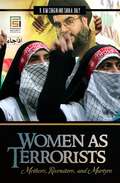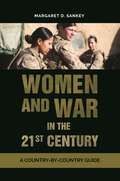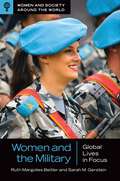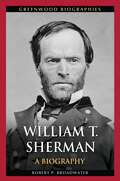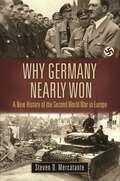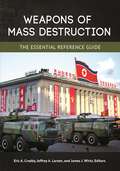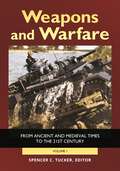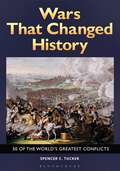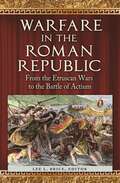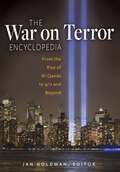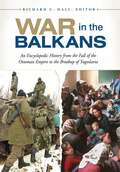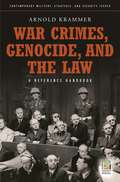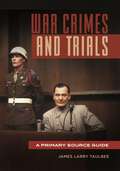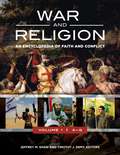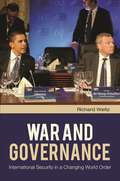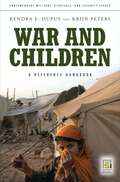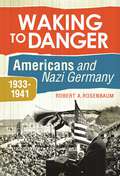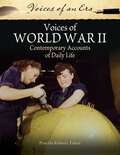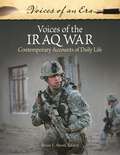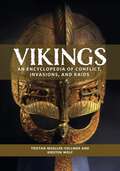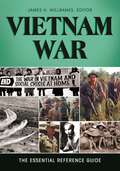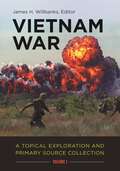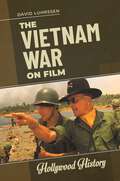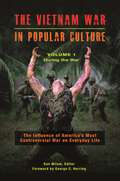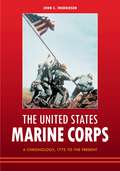- Table View
- List View
Women as Terrorists: Mothers, Recruiters, and Martyrs (Praeger Security International)
by R. Kim Cragin Sara A. DalyTwo international policy analysts scrutinize the increasingly important operative and support roles women play in various terrorist organizations around the world.Women as Terrorists: Mothers, Recruiters, and Martyrs is the first post-September 11 book to examine women's multifarious roles in terrorist organizations of all stripes around the world. It covers political, religious, ethno-separatist, and Maoist groups in countries as diverse as Iraq, Palestine, Chechnya, Sri Lanka, Colombia, South Africa, the Philippines, and Northern Ireland. Modeling terrorist organizations as purposive organizations that depend for support, recruitment, and rationale on a culturally defined community of sympathizers, the authors explore why women become involved in terrorist groups, how terrorist leaders turn the societal attributes of women to advantage in designing terrorist campaigns, and how women fight for the right to assume strategic and combat roles in terrorist groups. The authors conclude with a review and projection of the rapidly evolving trends in the use of women in terrorist organizations, paying particular attention to al-Qaeda and its affiliated groups and considering the implications of their findings for counterterrorist strategies.
Women and War in the 21st Century: A Country-by-Country Guide
by Margaret D. SankeyTwenty-three countries currently allow women to serve in front-line combat positions and others with a high likelihood of direct enemy contact. This book examines how these decisions did or did not evolve in 47 countries.This timely and fascinating book explores how different countries have determined to allow women in the military to take on combat roles—whether out of a need for personnel, a desire for the military to reflect the values of the society, or the opinion that women improve military effectiveness—or, in contrast, have disallowed such a move on behalf of the state. In addition, many countries have insurgent or dissident factions, in that have led armed resistance to state authority in which women have been present, requiring national militaries and peacekeepers to engage them, incorporate them, or disarm and deradicalize them.This country-by country analysis of the role of women in conflicts includes insightful essays on such countries as Afghanistan, China, Germany, Iraq, Israel, Russia, and the United States. Each essay provides important background information to help readers to understand the cultural and political contexts in which women have been integrated into their countries' militaries, have engaged in combat during the course of conflict, and have come to positions of political power that affect military decisions.
Women and the Military: Global Lives in Focus (Women and Society around the World)
by Ruth Margolies Beitler Sarah M. GersteinThis addition to the Women and Society around the World series explores the roles, challenges, and accomplishments of women in the military in countries across the globe.Around the world, millions of men serve in their countries' militaries, be it on land, on the seas, or in the air. But while many militaries have opened all positions to women, even those on the front lines, others remain closed. Countries have cited a number of reasons for their policies, including changing views of women and the military, conscription, and economic and demographic trends. Written by a professor of comparative politics at the United States Military Academy at West Point and an active duty army major, this book seeks to provide an understanding of women's roles in militaries around the world. The book is organized by region, exploring societal and cultural views of masculinity and war, as well as factors influencing changing views of women and the military, including conscription and economic and demographic trends. Topics also include sexual harassment, recruitment, and views on women's physicality and strength. High school students, undergraduates, and general readers will find this cross-cultural study a fascinating and important resource.
William T. Sherman: A Biography (Greenwood Biographies)
by Robert P. BroadwaterThis book tells the life story of William T. Sherman, one of the Civil War's most accomplished generals and an American military professional who changed how wars were fought.William T. Sherman: A Biography provides readers with a glimpse into the life of one of America's foremost military leaders and a top Union general in the Civil War. From his early life and military education, to his Civil War service and beyond, this book examines the career of a military professional who changed the way wars were fought. Prolific military history author Robert P. Broadwater follows Sherman's early development in the war and examines his most famous campaigns: the Atlanta Campaign, the March to the Sea, and the Carolinas Campaign. An engaging read, the book details how the iconic leader hailed as the first "modern" general achieved the military successes that enabled the North to achieve victory and bring the war to a close.
Why Germany Nearly Won: A New History of the Second World War in Europe (War, Technology, and History)
by Steven D. MercatanteThis book offers a unique perspective for understanding how and why the Second World War in Europe ended as it did—and why Germany, in attacking the Soviet Union, came far closer to winning the war than is often perceived.Why Germany Nearly Won: A New History of the Second World War in Europe challenges this conventional wisdom in highlighting how the re-establishment of the traditional German art of war—updated to accommodate new weapons systems—paved the way for Germany to forge a considerable military edge over its much larger potential rivals by playing to its qualitative strengths as a continental power. Ironically, these methodologies also created and exacerbated internal contradictions that undermined the same war machine and left it vulnerable to enemies with the capacity to adapt and build on potent military traditions of their own.The book begins by examining topics such as the methods by which the German economy and military prepared for war, the German military establishment's formidable strengths, and its weaknesses. The book then takes an entirely new perspective on explaining the Second World War in Europe. It demonstrates how Germany, through its invasion of the Soviet Union, came within a whisker of cementing a European-based empire that would have allowed the Third Reich to challenge the Anglo-American alliance for global hegemony—an outcome that by commonly cited measures of military potential Germany never should have had even a remote chance of accomplishing. The book's last section explores the final year of the war and addresses how Germany was able to hang on against the world's most powerful nations working in concert to engineer its defeat.
Weapons of Mass Destruction: The Essential Reference Guide
by Eric A. Croddy, Jeffrey A. Larsen, and James J. WirtzWhether one is interested in learning about anthrax, sarin, the neutron bomb—or any other weapon of mass destruction—this thorough and detailed reference is the place to find answers.The threat posed by weapons of mass destruction (WMD), whether nuclear, radiological, chemical, or biological, is the number-one topic of concern for the intelligence community, first responders, policymakers, and myriad non-governmental organizations—and many members of the general public. This authoritative reference will serve all of those parties by covering the full spectrum of mass-casualty weapons. The guide will not only enable people to educate themselves, but also to separate the truth from the spurious information that abounds. The book offers an A-to-Z listing of major topics, making finding information about concepts, scientific theories, and realities of WMD fast and easy. While the framework of WMD goes back centuries, the major focus of this reference is on weapons that date from the use of chemical warfare in World War I. The book also covers WMD from the early nuclear era (World War II), the Cold War, and the present (Syria, North Korea, etc.). Each entry is written in a clear, accessible style and includes crucial background information, making this book an essential resource for both lay readers and specialists. Armed with this portable database, readers will have the confidence to deal with, discuss, or write about WMD of all kinds based on an understanding of relevant concepts, policies, and scientific fundamentals.
Weapons and Warfare [2 volumes]: From Ancient and Medieval Times to the 21st Century [2 volumes] (Weapons And Warfare Ser.)
by Spencer C. TuckerThis work covers major weapons throughout human history, beginning with clubs and maces; through crossbows, swords, and gunpowder; up to the hypersonic railgun, lasers, and robotic weapons under development today.Weapons and Warfare is designed to provide students with a comprehensive and highly informative overview of weapons and their impact on the course of human history. In addition to providing basic factual information, this encyclopedia will delve into the greater historical context and significance of each weapon. The chronological organization by time period will enable readers to fully understand the evolution of weapons throughout history.The work begins with a foreword by a top scholar and a detailed introductory essay by the editor that provides an illuminating historical overview of weapons. It then offers entries on more than 650 individual weapons systems. Each entry has sources for further reading. The weapons are presented alphabetically within six time periods, ranging from the prehistoric and ancient periods to the contemporary period. Each period has its own introduction that treats the major trends occurring in that era. In addition, 50 sidebars offer fascinating facts on various weapons. Numerous illustrations throughout the text are also included.
Wars That Changed History: 50 of the World's Greatest Conflicts
by Spencer C. TuckerA thorough study of significant wars throughout history and their influence on world affairs—from the Egyptian Pharaoh Thutmore III's Campaigns during 479–459 BCE through the Iraq War of 2003–2011.For hundreds of years, wars have played a determining role in history and have decided the rise and fall of civilizations. Many believe that understanding the causes and consequences of warfare may move humankind towards world peace. This selection of the 50 most consequential wars, compiled by award-winning military historian Spencer C. Tucker, presents each conflict in chronological order and discusses its causes, its course, and its significance in world history.Through thoughtful essays and supporting visual evidence, this reference work examines the types of weapons systems employed and their effects in the field; the roles played by individual leaders such as Alexander the Great, Julius Caesar, Abraham Lincoln, and Adolf Hitler; and the impact of geography and economics on the battlefield. The work includes fascinating information about warfare, addressing subjects such as how transportation and logistics changed the face of war over time, what invention marked the ascendancy of infantry over cavalry, why World War I remains the most important war in the 20th century, and which war killed nearly half of the population of Germany. Each essay includes the latest interpretations of strategy, agendas, and consequences of the featured event.
Warfare in the Roman Republic: From the Etruscan Wars to the Battle of Actium
by Lee L. BriceThis easy-to-use reference book covers the most important people, places, events, and technologies of Roman warfare during the republic (400–31 BCE), providing a wealth of reference material and invaluable primary source documents.The study of ancient Rome remains both a high-interest topic and a staple of high school and university curricula, while recent Hollywood movies continue to heighten popular interest in Rome. This multi-format handbook examines warfare in ancient Rome during the republic period, from approximately 400 BCE to 31 BCE. Presenting ready reference, primary source documents, statistical information, and a chronology, the title explore all aspects of conflict during this time period, including key military leaders, pivotal battles and sieges, new weapons and technologies, and the intersections of warfare and society in the ancient world. The reference entries provide detailed snapshots of key people, events, groups, places, weapons systems, and strategies that enable readers to easily understand the critical issues during 400 years of the Roman Republic, while various overview, causes, and consequences essays offer engaging, in-depth coverage of the most important wars. By providing students with in-depth information about how the Roman Army operated, they develop a fuller understanding Roman, ancient, and world history.
The War on Terror Encyclopedia: From the Rise of Al-Qaeda to 9/11 and Beyond
by Editor Jan GoldmanThis fascinating reference chronicles the individuals, operations, and events of the War on Terror around the world, exploring its causes and consequences through the lens of policy, doctrine, and tactics of combat.The War on Terror is more than a political movement to identify and prosecute terrorists … it has become a cornerstone of economic and military importance. This campaign has shaped policy in the Middle East, prompted uprisings of Islamic fundamentalists against the West, and redefined the ideology of warfare. This single-volume encyclopedia provides readers with more than 200 engaging entries on the myriad events, key individuals, and organizations that have played a major role in the War on Terror.The A–Z entries define the policies and doctrines; describe the armies, battlefields, and weapons employed; and profile the figures whose actions and decisions set the course of history. The expert contributors decode military jargon for non-specialist readers and explain the unconventional tactics used in the War on Terror, shedding light on the reason behind the attacks, the political maneuvering of the leaders involved, and the internal conflicts and external clashes that drove terrorists to settle all over the world. The book also includes detailed essays on the impact of the September 11 attacks on U.S. foreign policy, presidential powers, and public opinion.
War in the Balkans: An Encyclopedic History from the Fall of the Ottoman Empire to the Breakup of Yugoslavia
by Richard C. Hall Jon C. Anderson Jr. Virginia Military Institute Walter F. Bell Bestami S. Bilgic Anna Boros Dino E. Buenviaje Frhs Antoine Capet Bert Chapman Bernard Cook Maeve Cowan Brig. Gen. Uzal W. Ent Gregory C. Ference Timothy L. Francis James W. Frusetta Neil A. Hamilton Laura J. Hilton Gordon E. Hogg John J. Horton Michael D. Johnson Robert B. Kane Gary Kerley Lucian N. Leustean Bonnie K. Levine-Berggren Alessandro Massignani Lisa McCallum Joseph McCarthy James Brian McNabb Karen Mead Marko Milivojevic Alexander Mikaberidze Josip Mocnik Irina Mukhina Michael S. Neiberg Jason Newman Christian Nuenlist Eric W. Osborne Ahmet Özcan Neville Panthaki Paul G. Pierpaoli Jr. John David Rausch Jr. Annette Richardson Karl Roider Margaret Sankey Mary Kate Schneider Charles R. Shrader Brian G. Smith Eva-Maria Stolberg David Tal James Tallon Brian C. Trueblood Spencer C. Tucker Brandon H. Turner Mesut Uyar Dierk Walter A. J. L. Waskey Tim J. Watts James H. Willbanks Hedley P. Willmott Anna M. Wittmann Fatih Yeşil Gültekin YildizThis authoritative reference follows the history of conflicts in the Balkan Peninsula from the 19th century through the present day.The Balkan Peninsula, which consists of Albania, Bulgaria, Romania, Moldova, and the former Yugoslavia, resides in the southeastern part of the European continent. Its strategic location as well as its long and bloody history of conflict have helped to define the Balkans' role in global affairs. This singular reference focuses on the events, individuals, organizations, and ideas that have made this region an international player and shaped warfare there for hundreds of years.Historian and author Richard C. Hall traces the sociopolitical history of the area, starting with the early internal conflicts as the Balkan states attempted to break away from the Ottoman Empire to the assassination of Archduke Franz Ferdinand that ignited World War I to the Yugoslav Wars that erupted in the 1990s and the subsequent war crimes still being investigated today. Additional coverage focuses on how these countries continue to play an important role in global affairs and international politics.
War Crimes, Genocide, and the Law: A Guide to the Issues (Contemporary Military, Strategic, and Security Issues)
by Arnold KrammerThis timely handbook offers an examination of man's history of war crimes and the parallel development of rules of war to prevent them in the future.Kosovo, Rwanda, Sierra Leone, Darfur, Auschwitz. War crimes have occurred in regions around the world and continue to this day. Although atrocities are as old as war itself, they did not become punishable crimes until the law evolved to define them as such. War Crimes, Genocide, and the Law: A Guide to the Issues examines the types of war crimes and the motivations behind them, as well as the laws that seek to control and abolish these heinous acts.Within the handbook, centuries of war crimes and genocides are analyzed and catalogued. At the same time, the author offers a history of the development of the rules of war, enabling readers to grasp the importance of such precedent-setting events as the 1946 Nuremberg Trials, and to see the gradual evolution of the laws intended to punish perpetrators and prevent future barbarism.
War Crimes and Trials: A Primary Source Guide
by James Larry TaulbeeThis comprehensive reference work serves as an important resource for anyone interested in the international prosecution of war crimes and how it has evolved.War Crimes and Trials analyzes the evolution of war crime trials through primary sources. Beginning with a general discussion of why regulations for war have evolved, it then illustrates the resulting changes in the nature and consequences of war as well as attitudes toward war as a part of international life. Moreover, it contextualizes contemporary rules that pertain to both international and non-international armed conflicts.The heart of the book focuses on 12 World War II cases central to the development of war law over the next 50 years, including the Nuremberg and Tokyo trials of major war criminals. It additionally dedicates discussion to the evolution of the law after World War II as set in motion by the United Nations, the 1949 Geneva Conventions and amendments, the background and operation of the ad hoc international criminal courts, and the creation of the permanent International Criminal Court, illustrating problems and successes through 12 cases drawn from these four courts.
War and Religion [3 volumes]: An Encyclopedia of Faith and Conflict [3 volumes]
by Jeffrey M. Shaw and Timothy J. Demy EditorsThis three-volume reference provides a complete guide for readers investigating the crucial interplay between war and religion from ancient times until today, enabling a deeper understanding of the role of religious wars across cultures.Containing some 500 entries covering the interaction between war and religion from ancient times, the three-volume War and Religion: An Encyclopedia of Faith and Conflict provides students with an invaluable reference source for examining two of the most important phenomena impacting society today. This all-inclusive reference work will serve readers researching specific religious traditions, historical eras, wars, battles, or influential individuals across all time periods.The A–Z entries document ancient events and movements such as the First Crusade that began at the end of the 10th century as well as modern-day developments like ISIS and Al Qaeda. Subtopics throughout the encyclopedia include religious and military leaders or other key people, ideas, and weapons, and comprehensive examinations of each of the major religious traditions' views on war and violence are presented. The work also includes dozens of primary source documents—each introduced by a headnote—that enable readers to go directly to the source of information and better grasp its historical significance. The in-depth content of this set benefits high school and college students as well as scholars and general readers.
War and Governance: International Security in a Changing World Order (The Changing Face of War)
by Richard WeitzAn insightful and expert assessment examines how best to end—and avert—wars.How do we avoid war? To arrive at an answer, master analyst Richard Weitz explores the ways nations, international organizations, and individuals have sought to bring order to an inherently disorderly phenomenon—potential and actual violent conflict among organized political entities. Specifically, War and Governance: International Security in a Changing World Order analyzes a number of critical issues such as whether regional security institutions have distinct advantages and liabilities in promoting international security, as compared with universal organizations like the United Nations. Other important questions are addressed, as well. How will international organizations, such as the UN, EU, and NATO, change the nature of war in the 21st century—and be changed by it? What role might less formal institutions and nongovernmental organizations play in peacemaking? Will the nation-state remain the most important international security actor? The book ends with a gap analysis that identifies incongruities between international needs and capabilities—and suggests ways to overcome them.
War and Children: A Reference Handbook (Contemporary Military, Strategic, and Security Issues)
by Kendra E. Dupuy Krijn PetersA comprehensive, up-to-date presentation of how children and young people are affected by and respond to situations of armed conflict and postwar reconstruction.War and Children: A Reference Handbook looks at one of the most wrenching aspects of armed conflict, ranging across the globe to examine the different ways armed conflict and postwar reconstructions affect children and young people, and how they have responded to both war and efforts to alleviate war's destruction.While war has always affected children, the nature of that impact has changed in the last half-century. Civil conflicts break out in mostly poor, developing countries with large populations of young people, and combatants are less hesitant to turn civilian areas into battlegrounds. War and Children explores these phenomena by focusing primarily on recent conflicts worldwide, with case studies dramatizing important issues and controversies-including the considerable number of children soldiers throughout the world.
Waking to Danger: Americans and Nazi Germany, 1933-1941
by Robert A. RosenbaumThis intriguing study is the first comprehensive survey of American public opinion about Nazi Germany in the prewar years.The 1930s were years when Americans struggled to define their country's role in a dangerous world. Opinions were deeply divided and passionately held. Waking to Danger: Americans and Nazi Germany, 1933-1941 traces the evolution of American public opinion about Germany as it spiraled from ignorance and isolationism to a sense of danger and interventionism. This brief, but broad survey fills a gap in the historical literature by bringing together, for the first time, the reactions toward Nazi Germany of a variety of groups—peace advocates, Jews, fascists, communists, churches, the business community, and the military—that have hitherto only been treated separately in monographic literature. The result is a picture of evolving national public opinion that will be a walk down memory lane for the members of The Greatest Generation, while offering those who did not live through these turbulent years a fresh understanding of the era.
Voices of World War II: Contemporary Accounts of Daily Life (Voices of an Era)
by Priscilla RobertsDrawing together a wide variety of primary source documents from across the United States, Europe, and Asia, this book illuminates the events and experiences of World War II—the most devastating war in human history.World War II was the most destructive and disruptive war ever, a global conflict that in one way or another affected the lives of people across the planet. Voices of World War II: Contemporary Accounts of Daily Life coalesces a wide variety of primary source documents drawn from across the United States, Europe, and Asia. Supplemented by interpretive material that enables readers to analyze them, assess their impact and significance, and place them in context to comparable situations today, the documents provide rare insights into World War II. Expert commentaries and additional information on these texts enable a greater understanding of the background to these documents, providing valuable training in learning to interpret, assess, and evaluate historical sources. Intended primarily for upper-level high school and undergraduate-level history students, general readers will also appreciate the variegated array of primary material from World War II, which depicts numerous aspects of the conflict, often in extremely personal terms.
Voices of the Iraq War: Contemporary Accounts of Daily Life (Voices of an Era)
by Brian L. SteedThe Iraq War (2003–2011) was the most significant conflict in the early 21st century. This book examines the ongoing importance of this war for the Middle East and the world today through first-person accounts of the war and primary source documents.Voices of the Iraq War: Contemporary Accounts of Daily Life illuminates the complex and poorly reported realities of the conflict that those without direct experience cannot possibly fathom, presenting detailed personal accounts of what the conflict in Iraq was like across multiple disciplines and through a variety of viewpoints. The accounts are based on interviews with American, Iraqi-American, and British officers who deployed and fought throughout the country of Iraq.The book begins with the story of an Iraqi boy who flees Iraq with his family after Desert Storm and then returns to Iraq as a translator to assist U.S. forces nearly 16 years later. The book is filled with personal accounts of combat and training as well as other real-world experiences that define what the Iraq War meant to thousands of U.S. and allied service members. These personal accounts are supported with national level policy speeches and official statements that help readers put the individual stories and events in national, regional, and global perspective. The book concludes by examining the impact of this war on thousands of young men and women that will last for decades to come.
Vikings: An Encyclopedia of Conflict, Invasions, and Raids
by Tristan Mueller-Vollmer Kirsten WolfFor three centuries, the Vikings changed the political world of northern and western Europe. This encyclopedia explores exactly how they did it in a highly readable and informative resource volume.How did the Vikings know when to strike? What were their military strengths? Who were their leaders? What was the impact of their raids? These and many more questions are answered in this volume, which will benefit students and general readers alike.The only encyclopedia devoted specifically to the topic of conflict, invasions, and raids in the Viking Age, this book presents detailed coverage of the Vikings, who are infamous for their violent marauding across Europe during the early Middle Ages. Featuring extracts of poetry and prose from the Viking Age, the book provides cultural context in addition to an in-depth analysis of Viking military practices.
Vietnam War: The Essential Reference Guide
by James H. WillbanksThe Vietnam War was one of America's longest, bloodiest, and most controversial wars. This volume examines the complexities of this protracted conflict and explains why the lessons learned in Vietnam are still highly relevant today.Vietnam War: The Essential Reference Guide provides a compendium of the key people, places, organizations, treaties, and events that make up the history of the war, explaining its causes, how it was conducted, and its far-reaching consequences. Written by recognized authorities, this ready-reference volume provides essential information all in one place and includes a comprehensive list of additional sources for further study.The work presents a detailed chronology that outlines the numerous battles and campaigns throughout the war, such as the Tet Offensive, the Battle of Hamburger Hill, Operation Rolling Thunder, and the Battle of Hue. Biographies on Lyndon Johnson, William Westmoreland, Robert McNamara, Ngo Dinh Diem, and other major political figures and military leaders provide insight into the individuals who played key roles in the conflict, while primary source documents such as President Nixon's speech on Vietnamization provide invaluable historical context.
Vietnam War [2 volumes]: A Topical Exploration and Primary Source Collection [2 volumes]
by James H. WillbanksThis detailed two-volume set considers the Vietnam War, one of America's longest and bloodiest wars, from a topical perspective, addressing the main characters and key events of the war and supplying many relevant primary source documents.The Vietnam War not only claimed the lives of nearly 60,000 Americans and more than a million Vietnamese, but the prolonged conflict also resulted in a firestorm of protest at home that shook the foundations of the country and made U.S. citizens question the moral principles and motivations behind our foreign policy and military actions.Written in a very accessible style by recognized authorities on the war, Vietnam War: A Topical Exploration and Primary Source Collection provides students and general readers with a complete overview of the conflict in Vietnam—a broad topic that remains an important part of the American history and world history curriculum. Using a topical approach to cover all aspects of the war, the set enables students to see the complete picture of the conflict through its presentation of reference entries and documents arranged in cohesive, compelling chapters. Examples of the primary documents in the set include "Communist Party: Evaluation of the Tet Offensive" (1968) and President Richard Nixon's Speech on Vietnamization (1969). These primary sources are augmented by oral histories of soldiers who fought in the Tet Offensive. Additionally, maps and images in each section enhance the aesthetic appeal of the book and heighten students' understanding of the material. Readers will come away with both a strong comprehension of the Vietnam War as well as an appreciation for how significant this proxy conflict was as a lead-up event to the global Cold War.
The Vietnam War on Film (Hollywood History)
by David LuhrssenVietnam War on Film illustrates how to employ film as a teaching tool. It also stands on its own as an account of the war and the major films that have depicted it.Even for many people who experienced the Vietnam War first hand, memories of that conflict have often been shaped by the popular films that depicted it: The Quiet American, The Green Berets, The Deer Hunter, Coming Home, Platoon, Full Metal Jacket, and Apocalypse Now, among others. Vietnam War on Film examines how the war is portrayed through a selection of ten iconic films that represent the war through dramatization and storytelling as opposed to through documentary footage. The book includes an introduction to the war's history and a timeline of events, followed by ten chapters, each of which focuses on a specific Vietnam War movie. Chapters offer a uniquely detailed level of historical context for the films, weighing their depiction of events against the historical record and evaluating how well or how poorly those films reflected the truth and shaped public memory and discourse over the war. A final section of "Resources" provides a comprehensive annotated bibliography of print and electronic sources to aid students and teachers in further research.
The Vietnam War in Popular Culture [2 volumes]: The Influence of America's Most Controversial War on Everyday Life [2 volumes]
by Editor Ron MilamCovering many aspects of the Vietnam War that have not been addressed before, this book supplies new perspectives from academics as well as Vietnam veterans that explore how this key conflict of the 20th century has influenced everyday life and popular culture during the war as well as for the past 50 years.How did the experience of the Vietnam War change the United States, not just in the 1950s through the 1970s, but through to today? What role do popular music and movies play in how we think of the Vietnam War? How similar are the recent wars in Iraq and Afghanistan—and now Syria—to the Vietnam War in terms of duration, cost, success and failure rates, and veteran issues? This two-volume set addresses these questions and many more, examining how the Vietnam War has been represented in media, music, and film, and how American popular culture changed because of the war.Accessibly written and appropriate for students and general readers, this work documents how the war that occurred on the other side of the globe in the jungles of Vietnam impacted everyday life in the United States and influenced various entertainment modes. It not only covers the impact of the counterculture revolution, popular music about Vietnam recorded while the war was being fought (and after), and films made immediately following the end of the war in the 1970s, but also draws connections to more modern events and popular culture expressions, such as films made in the aftermath of September 11, 2001. Attention is paid to the impact of social movements like the environmental movement and the civil rights movement and their relationships to the Vietnam War. The set will also highlight how the experiences and events of the Vietnam War are still impacting current generations through television shows such as Mad Men.
The United States Marine Corps: A Chronology, 1775 to the Present
by John C. FredriksenThis comprehensive survey profiles one of history's greatest fighting forces, on land, sea, and air.The United States Marine Corps: A Chronology, 1775 to the Present touches upon all aspects of the Continental and U.S. Marine Corps since their inception. All major battles in all major wars are covered, along with innumerable smaller clashes and deployments abroad. The evolution of amphibious doctrine, so essential to Marine Corps activity in the 20th and 21st centuries, is likewise covered in detail, along with the rise of Marine Corps aviation.Through a diary of daily occurrences proffered in the context of greater historical events, this chronology captures the entire sweep of U.S. Marine Corps history. It follows the Corps from the American Revolution to the halls of Montezuma and the shores of Tripoli, through World Wars I and II, and up to Operation IRAQI FREEDOM and Operation ENDURING FREEDOM in Afghanistan. Entries delineate battlefield events, but also significant political and administrative changes that have affected the Marines. Notable events in the careers of generals and other individuals are included as well.
